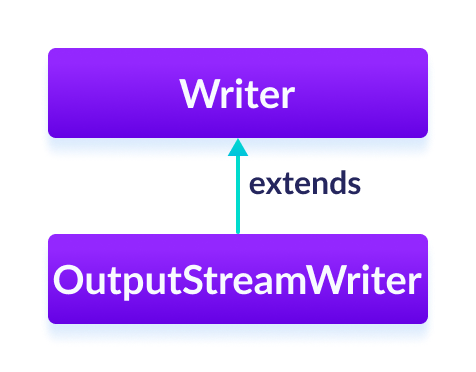The OutputStream class of the java.io package is an abstract superclass that represents an output stream of bytes.
Since OutputStream is an abstract class, it is not useful by itself. However, its subclasses can be used to write data.
Subclasses of OutputStream
In order to use the functionality of OutputStream, we can use its subclasses. Some of them are:

We will learn about all these subclasses in the next tutorial.
Create an OutputStream
In order to create an OutputStream, we must import the java.io.OutputStream package first. Once we import the package, here is how we can create the output stream.
// Creates an OutputStream
OutputStream object = new FileOutputStream();
Here, we have created an object of output stream using FileOutputStream. It is because OutputStream is an abstract class, so we cannot create an object of OutputStream.
Note: We can also create the output stream from other subclasses of the OutputStream class.
Methods of OutputStream
The OutputStream class provides different methods that are implemented by its subclasses. Here are some of the methods:
write()- writes the specified byte to the output streamwrite(byte[] array)- writes the bytes from the specified array to the output streamflush()- forces to write all data present in output stream to the destinationclose()- closes the output stream
Example: OutputStream Using FileOutputStream
Here is how we can implement OutputStream using the FileOutputStream class.
import java.io.FileOutputStream;
import java.io.OutputStream;
public class Main {
public static void main(String args[]) {
String data = "This is a line of text inside the file.";
try {
OutputStream out = new FileOutputStream("output.txt");
// Converts the string into bytes
byte[] dataBytes = data.getBytes();
// Writes data to the output stream
out.write(dataBytes);
System.out.println("Data is written to the file.");
// Closes the output stream
out.close();
}
catch (Exception e) {
e.getStackTrace();
}
}
}
In the above example, we have created an output stream using the FileOutputStream class. The output stream is now linked with the file output.txt.
OutputStream out = new FileOutputStream("output.txt");
To write data to the output.txt file, we have implemented these methods.
output.write(); // To write data to the file
output.close(); // To close the output stream
When we run the program, the output.txt file is filled with the following content.
This is a line of text inside the file.
To learn more, visit Java OutputStream (official Java documentation).